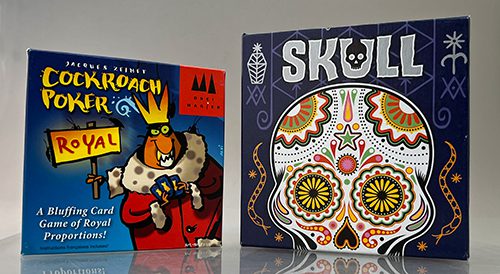
Cockroach Poker Royal
While I’ve written about Cockroach Poker Royal before, I like this game so much I’m happy to tell people about it whenever I have the chance.
Cockroach Poker Royal is all about not collecting four of the creatures in the game.
The cards consist of seven types of creepy-crawlies: Rats, Cockroaches, Stink Bugs, Flies, Bats, Toads, and Scorpions. There are eight of each type in the deck, plus one Royal per critter. (Easily identified by the large golden crown atop the head of the creature in question.)
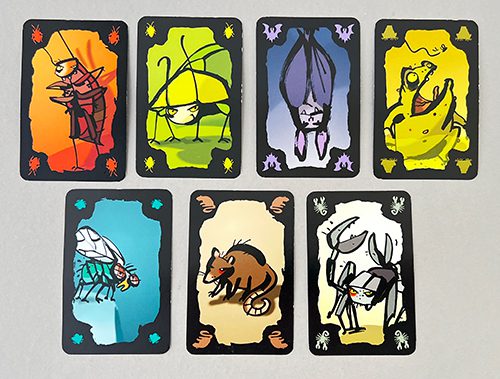
To start the game, shuffle the deck and deal seven cards, face down, to form the penalty pile. Then deal all the remaining cards to all the players.
The randomly selected starting player then takes a card from their hand and places it face down on the table. They then slide the card in front of another player, making a simple statement about the card. For instance:
“This is a Stinkbug”
or
“This is a Toad”
Since this is a bluffing game, both statements could be used for the same card, regardless as to what the card actually is.
The receiving player then has a choice to make: They can accept the card and state whether the starting player was telling the truth or they can pass the card.
If passing, they take a look at the card and slide it in front of another player, making their own statement about the card—a statement that could agree with the original statement or completely contradict it.
Whenever a player accepts a card (either by choice or because there’s no one else to pass it to), they must decide if the last person’s statement is true or not. If they guess correctly, the card goes back, face up, in front of the last sender. If they’re wrong, the face up card stays in front of them.
What separates Cockroach Poker Royal from its more pedestrian predecessor, Cockroach Poker, is the addition of the Royal cards and that small but costly deck of penalty cards.
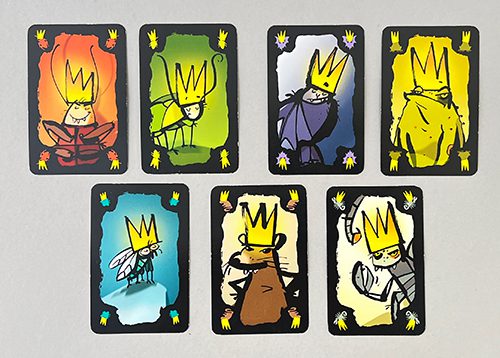
Not only do the Royals provide players with an additional type of card to state when passing a card but, more importantly, there are additional penalties for being on the wrong side of a Royal card. Under normal circumstances, if you’re forced to take a card, you only take that one card. In the Royal, if that card is a Royal card, you also must take a card from the penalty pile. And if that card turns out to be a Royal, you must take another card from the Penalty pile.
The first player to have four of any creature, or four Royals, in front of them loses and the remaining players win.
Skull
Skull is such a perfect bar table game, the cards even look like drink coasters.
In Skull, players are also looking to either successfully make two bids or not be the last person eliminated.
Each player is given a square mat and a deck of four cards, each with their own distinctive color and design pattern. Three of these cards are flowers, the fourth is a skull.
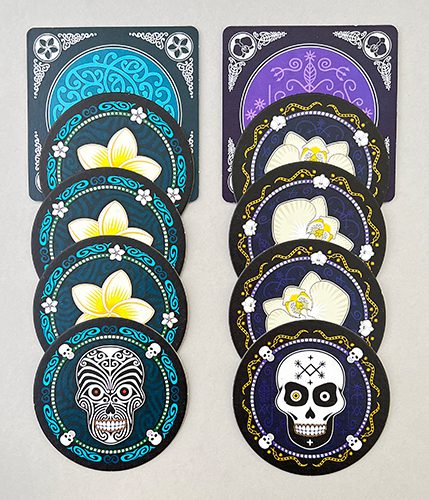
Players start each round by placing one of their cards face down on their player mat. Once play returns to the starting player, players then have a decision to make: do they play another card or do they make an opening bid as to how many cards they can turn over around the table with flowers on them? Provided the starting player plays another card, each player to their left has to make the same choice: play a card or bid.
Once a player makes an opening bid, all other players must either bid a number higher than the original bid, or pass.
The player who wins the bid then must reveal only flower cards, both their own and those of others, up to the winning bid. If they do so, they flip their player mat over and are one successful bid away from winning.
The catch is that the player who wins the bid must start by turning over all of their own cards first. This means you have to be careful with your bidding—if everyone calls your bluff and stops bidding, you may get stuck with a bid you didn’t want to make, forcing you to reveal your own skull—you know, the one you were hoping someone else who outbid you would reveal.
If you reveal a skull, you must shuffle all your own cards and allow another player to randomly select one. That card gets discarded back into the box, leaving you to continue playing with only three cards.
And when you’re reduced to three cards, or two cards, or are down to just a single card, your options become greatly reduced, and your decisions on when to bid become more forced. (You can’t play all of your cards if one of them is your skull!)
So, Cockroach Poker Royal or Skull?
Both Cockroach Poker Royal and Skull are fun games that play best with four to six players. Turns are surprisingly fast and, despite the focus being on one or two players, everyone around the table will be smiling, wondering how it’s going to resolve. In my plays of each game, turns have ended in laughter, regardless of the outcome. Rounds will end with second-guessing, and plenty of post-turn analysis amidst the laughter.
For me, these are the kinds of moments that create good gaming memories.
Personally, I enjoy both games. I will acknowledge, however, that choosing one over the other depends on where you’re playing or who you’re playing with.
It’s one thing to imagine yourself cooly staring down James Bond across a poker table, a wry smile across your lips, all-but daring him to call your bluff. But, do you have what it takes to lie to your friends? Or pretend to lie to your friends? Or see through their lies or recognize their truths?
I get that bluffing games aren’t for everyone. There’s something visceral about a bluffing game that can lean hard on trust issues. Cockroach Poker Royal frequently involves in-your-face lying to someone across the table. If you or your friends aren’t comfortable with that, Skull is the better choice. Stripped down, Skull is really a hidden bidding game, one without direct falsehoods or misdirection.
Provided you and your group are okay with bluffing games, there are some important differences. Cockroach Poker Royal takes longer to play and more space at a table. As each player inevitably starts collecting sets of different types of critters, a small table will get crowded quickly.
With Skull, each player has a square mat that’s only slightly larger than the round cards themselves. Skull also requires less talking—in fact, you could play the game silently by raising fingers to indicate the number of your bid if you wanted to. If I was going to a party or a bar, Skull would be my choice.
All things being equal, however, I will bring out Cockroach Poker Royal every time. There’s something menacing, in a cartoonish way, about the artwork that always draws people into the game. I enjoy the progressive bluffing aspect as well as the way a single card can make its way around the table, with everyone knowing the truth except for the last person. Cockroach Poker Royal creates a more enjoyable, shared tension—and more laughter—than I’ve experienced when playing Skull.
Still, both games sit side-by-side in my collection and I wouldn’t think of trading away either one. Each game does what it sets out to do and does it very well. If either (or both!) appeals to you, I encourage you to give them a try.
Skull is #91 on the 100 most important board games of the 2010s


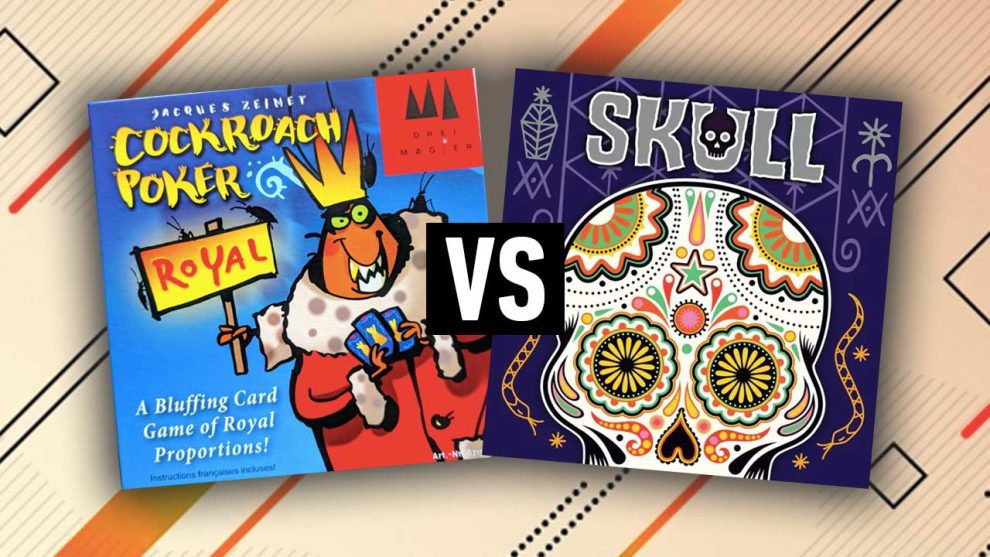









Add Comment